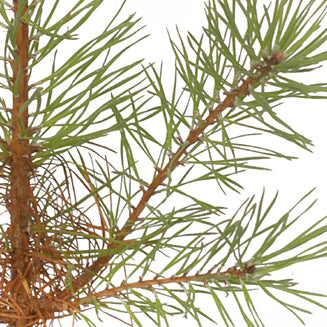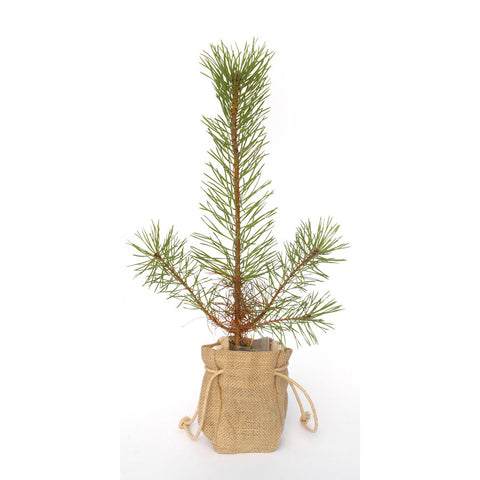Scots Pine Tree Facts and Information
- Latin name: Pinus sylvestris
- Native words: Old Irish () Scots Gaelic (Ghuibhas) Old English () Welsh (ffynidwydden) eastern Celtic ()
- Ogham sign: IA
- Height when mature: 30-40m (98-130ft)
- Height after 10 years: 2-3m

Scots Pine botanical description:
Our only native Conifer tree, ancient woods of Scots Pine are now very rare, but the species is widely planted throughout the UK.
It can develop either as a tall single trunked tree with a high crown or a multi stemmed spreading variety. Notable for its scaly red brown bark and of course the pine cones.
Scots Pines will live on average 250-300 years. As they grow older, the trunk becomes more and more layered with thick woody scales which overlay each other.
The blue green needles sit in pairs, and flower buds which are covered in resin for protection open up in May. In May, both male and female flowers develop on the one tree and the cones develop in April two years later, opening while still on the tree. The seeds are wind dispersed and travel 50-100m on average.
The heavy fall of needles means the soil becomes acidic and other plants struggle to grow underneath mature pines. Ironically, Scots Pine itself does not germinate in such conditions and relies on the seeds landing in clearings or away from the woodland. Seeds may also be carried and buried by squirrels, but fire probably played a key part in clearing old growth. This means that Scots Pine woods are often mobile and their locations differ around over time.
Scots Pine ooze resin (actually the sap), which prevents attack by insects and acts as a preservative. Dead pines are a natural feature of forests, kept from decay by the resin. The other trees that will grow with Scots Pine are Birch species (Downy, Silver) and Rowan.
Scots Pine natural history and ancient wisdom:
Naturally growing Scots Pine is now confined to just 17 000 hectares of in the Scottish Highlands.
Scots Pine was one of the first pair of trees to colonise Britain (the other being birch), and was once widespread.
The vast Caledonian Pine forests which stretched across upland Scotland were dominated by Scots Pine. However, they were widely felled during the 17th and 18th centuries as fuel for foundries as well as to make way for grouse moors. The straight trunks were used for ships masts, and even the resin was utilised to seal beer barrels.
Nowadays, the best place to see Pine in its original habitat is in places such as Glen Affric, and Beinn Eighe in Scotland. The last ‘original’ Scots Pine in Ireland died in 1866.
There is very little ancient wisdom, which is probably due to the loss of the folklore of the Picts the people who inhabited Scotland in early times In the old Gaelic alphabet, where each letter is denoted by a tree whose name starts with the letter, the Scots pine is not listed under its Gaelic name of Guibhas but rather under P for Peith, which is the alternative Gaelic for the tree.

Scots Pine place names:
- Allt na Ghuibhas (Wester Ross)
Scots Pine wildlife rating:
The ecology of Scots Pine is intertwined with some of Britain’s rarest wildlife. In the Caledonian Pine forest Capercaillie, the biggest of the grouse performs it courtship in the ‘leks’ or clearings among the pines.
Crested Tits move among the branches looking for insects and Scottish Crossbills feed on the seeds within the cones using their scissor like beak to open them up.
Scots Pine good points / bad points:
- Best suited for large gardens, to which it gives a stately aspect.
- Seeps resin from the trunk.
- Heavy fall of needles which prevents many other plants from growing.
Buy a Scots Pine Tree
Send a tree gift from the award winning tree gifts company Tree2mydoor. We have been specialising in tree gifts for over 20 years now and we've loved every minute!